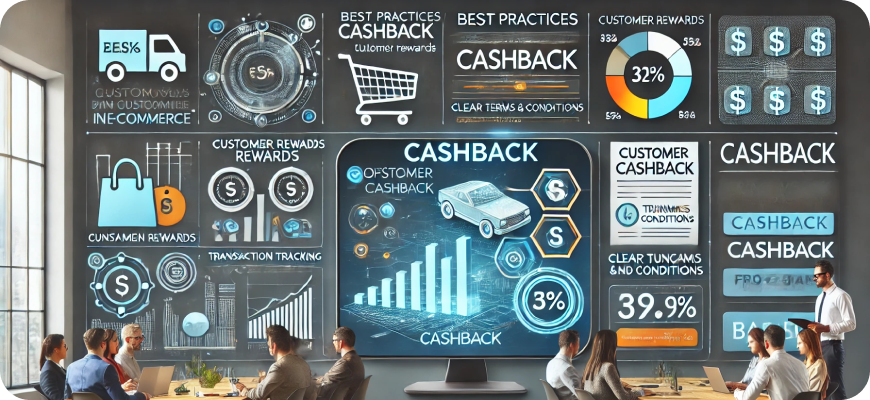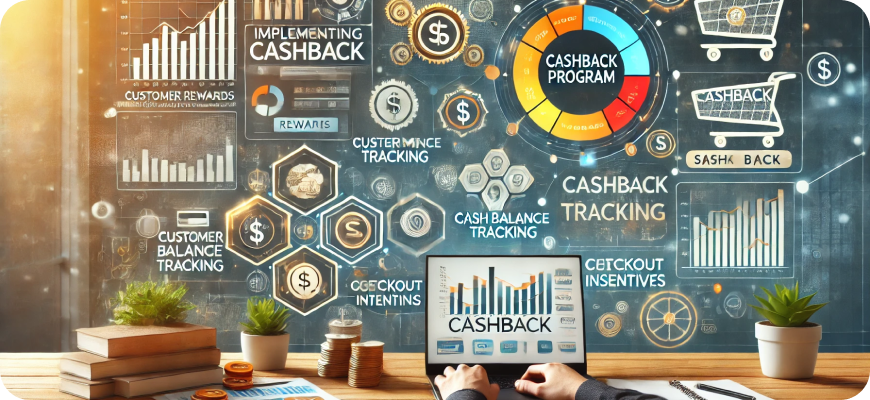Offer cash back on you ecommerce from TODAY.
Cashback offers are a powerful way to incentivize purchases, attract new customers, and encourage repeat business. In the competitive world of e-commerce, cashback programs provide a unique value proposition that resonates with deal-seeking shoppers and can boost your brand’s visibility and loyalty. With increasing customer demand for rewards and savings, offering a cashback program can set your e-commerce business apart, enhance customer retention, and even increase average order value. This guide explores the benefits of offering cashback, strategies for implementing a cashback program, and practical tips to launch one starting today.

Why Offer Cashback on Your E-Commerce Store?
A cashback program can benefit both your customers and your business. Here’s how:
- Increases Customer Acquisition: Cashback offers attract deal-seeking shoppers who may not have otherwise considered your store. This can help you capture new customers and compete effectively in a crowded marketplace.
- Encourages Repeat Purchases: Customers are more likely to return and make additional purchases if they know they’ll receive rewards. Cashback creates a cycle of earning and spending that strengthens customer loyalty.
- Boosts Average Order Value (AOV): Cashback incentives encourage shoppers to spend more per transaction. For example, offering cashback on purchases over a certain amount can motivate customers to increase their cart size.
- Improves Customer Retention: With regular rewards, customers are less likely to switch to competitors. Retaining customers through cashback is cost-effective compared to constantly acquiring new ones.
- Differentiates Your Brand: Offering cashback can distinguish your store from competitors who may only offer discounts. This can position your brand as one that provides long-term value.
Types of Cashback Programs for E-Commerce
There are several types of cashback programs to consider, depending on your business model, target audience, and goals.
1. Flat Rate Cashback
A simple approach, where customers receive a fixed percentage of cashback on every purchase. For example, offering 5% cashback on all purchases gives customers a straightforward reward structure.
2. Tiered Cashback
Tiered cashback incentivizes larger purchases by offering higher cashback percentages as order value increases. For instance, you could offer 3% cashback on orders up to $50, 5% on orders between $50 and $100, and 10% on orders over $100.
3. Category-Based Cashback
This type of program offers cashback on specific product categories, such as 8% cashback on electronics or 10% on beauty products. This encourages customers to explore and buy from those categories.
4. Limited-Time Cashback
Limited-time offers create urgency, motivating customers to make purchases within a certain timeframe. For example, a “10% cashback for the next 48 hours” can drive immediate sales and increase engagement.
5. Cashback for New Customers
This option targets customer acquisition by offering cashback exclusively for first-time buyers. A 15% cashback for new customers, for instance, can attract new visitors and incentivize them to make their first purchase.
6. Cashback with Loyalty Programs
Integrating cashback with a loyalty program rewards customers for their loyalty and encourages them to keep shopping with you. For example, you could offer 5% cashback for loyalty program members, while non-members receive 2%.
How to Set Up a Cashback Program
Setting up a cashback program for your e-commerce store requires a well-thought-out plan. Here’s a step-by-step approach to help you implement it effectively.
Step 1: Define Your Goals
Determine the main objective of your cashback program:
- Customer Acquisition: Design a program that attracts new shoppers, such as offering a higher cashback rate for first-time buyers.
- Customer Retention: Implement a program that rewards repeat purchases and increases customer loyalty.
- Increase Average Order Value: Use a tiered cashback program to encourage larger purchases.
Having clear goals will help you design a program that aligns with your business needs.
Step 2: Set the Cashback Amount
Decide on the cashback percentage or amount that’s financially sustainable for your business. Evaluate factors like:
- Profit Margins: Ensure that the cashback rate doesn’t eat into your profits.
- Customer Spending Behavior: Analyze customer spending habits to set a cashback amount that motivates but doesn’t overspend on incentives.
It’s essential to strike a balance between offering an attractive reward and maintaining profitability.
Step 3: Choose a Redemption Method
Decide how customers will redeem their cashback:
- Store Credit: Offering cashback as store credit encourages repeat purchases since customers can only redeem it within your store.
- Direct Bank Transfers: For businesses with high-profit margins, you can allow cashback to be redeemed as cash or transferred to the customer’s bank account.
- Third-Party Wallets: Use popular digital wallets like PayPal or other regional e-wallets, which provide flexibility and appeal to tech-savvy customers.
Step 4: Implement Cashback Tracking
For a seamless experience, use reliable cashback tracking software or integrate a plugin that automatically tracks, calculates, and applies cashback for eligible transactions. Many e-commerce platforms, including Shopify and WooCommerce, offer cashback plugins that handle this efficiently.
Step 5: Establish Clear Terms and Conditions
To avoid misunderstandings, clearly define and communicate the terms of your cashback program:
- Eligible Purchases: State which purchases or categories qualify for cashback.
- Expiration Dates: Indicate if cashback rewards expire, such as within 90 days or a year from the earning date.
- Minimum Redemption Amount: Some stores set a minimum cashback balance required for redemption, encouraging customers to make additional purchases.
Step 6: Promote the Program
Once your cashback program is set up, it’s essential to promote it effectively. Use channels like email marketing, social media, and your website banners to inform customers of the cashback offer. Make it easy for customers to understand the program’s benefits and encourage them to take advantage of it.
Best Practices for Offering Cashback in E-Commerce

To make your cashback program successful, consider the following best practices:
1. Make It Simple and Transparent
Complex cashback structures can confuse customers, reducing engagement. Keep your cashback program straightforward, with clear terms and accessible tracking. Transparency also builds trust and prevents dissatisfaction.
2. Encourage Bigger Purchases with Tiered Cashback
Tiered cashback structures incentivize customers to spend more to unlock higher rewards. For example, you could offer 5% cashback on purchases up to $50 and 10% on purchases over $100, driving higher average order values.
3. Use Time-Limited Cashback Offers
Time-sensitive cashback offers create urgency, encouraging customers to make immediate purchases. For instance, a 15% cashback deal that’s only available for 24 hours can drive traffic and generate sales during a specific period.
4. Integrate Cashback with Other Promotions
Offer cashback alongside existing promotions like discounts or free shipping. For instance, if customers receive 10% off their order and 5% cashback, the combined offer enhances perceived value and drives conversions.
5. Promote Cashback on High-Margin Products
Promote cashback specifically for high-margin products to maintain profitability. For instance, if your profit margins are higher on accessories, you could offer a higher cashback rate for those products, increasing sales without cutting into profits significantly.
How to Track and Analyze Cashback Program Performance
To ensure your cashback program is effective, regularly analyze its performance. Key performance indicators (KPIs) to monitor include:
- Customer Acquisition Rate: Measure the rate at which new customers are joining through the cashback program. Compare this to your baseline acquisition rate to determine if the program is attracting new shoppers.
- Customer Retention Rate: Analyze whether existing customers are returning and making repeat purchases after joining the cashback program.
- Average Order Value (AOV): Track if the cashback program is boosting AOV by encouraging customers to spend more to maximize their cashback.
- Redemption Rate: Check how often customers redeem their cashback rewards. A high redemption rate indicates that customers find value in the program, while a low rate may require adjustments to make cashback rewards more appealing.
- Customer Lifetime Value (CLTV): Measure the long-term impact of cashback on customer lifetime value. Over time, an effective cashback program should increase CLTV as customers make more purchases to earn rewards.
Examples of Successful Cashback Programs
1. Rakuten (Ebates)
Rakuten offers cashback on purchases made at partner stores, providing users with rewards for shopping online. Users can earn cashback as a percentage of their purchase amount and redeem their rewards through PayPal or check.
2. Amazon’s Cashback Credit Cards
Amazon offers cashback credit cards that reward users for purchases on Amazon and at other partner retailers. Customers earn cash back as points that they can redeem for future purchases, offering a seamless way to save while shopping.
3. PayPal’s Cashback Program
PayPal offers cashback rewards for purchases made with select merchants. Customers can view eligible cashback offers, activate them, and receive cashback directly to their PayPal account, making it easy to save and track rewards.
Tips for Promoting Your Cashback Program
1. Highlight Cashback on Key Pages
Promote your cashback program on your homepage, product pages, and checkout pages, ensuring customers are aware of the offer. Use banners, pop-ups, or announcements to increase visibility.
2. Send Cashback Reminder Emails
Email marketing is an effective way to remind customers about cashback rewards. For example, send an email highlighting the cashback program or notify customers when they’ve earned new rewards, encouraging them to redeem them on your store.
3. Leverage Social Media
Share information about your cashback program on social media platforms. Use posts, stories, and ads to reach a broader audience and educate followers about the benefits of shopping with cashback.
4. Collaborate with Influencers
Partner with influencers to promote your cashback program. Influencers can explain how the program works, showcase eligible products, and highlight the benefits, driving more interest and participation.

Conclusion
Cashback programs offer a powerful way to increase customer engagement, drive conversions, and improve retention in e-commerce. By implementing a simple, transparent, and well-targeted cashback program, you can attract deal-seeking shoppers, encourage repeat purchases, and differentiate your brand from competitors. From setting clear goals and selecting the right redemption method to promoting your program through various channels, this guide provides a step-by-step approach to offering cashback starting today. Embrace this strategy to add value for your customers and build a more loyal customer base in the competitive e-commerce landscape.






